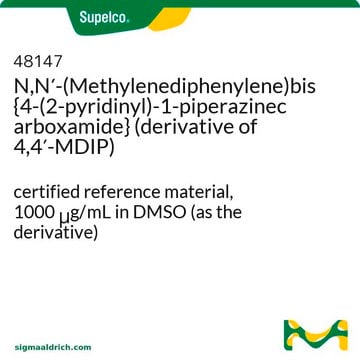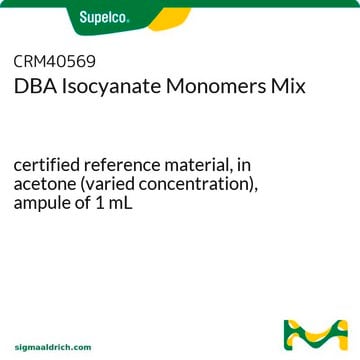P24101
Diphenyl ether
ReagentPlus®, 99%
Synonyme(s) :
Diphenyl oxide, Phenyl ether
About This Item
Produits recommandés
Densité de vapeur
>5.86 (25 °C, vs air)
Niveau de qualité
Pression de vapeur
<1 mmHg ( 20 °C)
Gamme de produits
ReagentPlus®
Pureté
99%
Forme
crystals
Température d'inflammation spontanée
1144 °F
Limite d'explosivité
1.5 %
Indice de réfraction
n20/D 1.579 (lit.)
Point d'ébullition
259 °C (lit.)
Pf
25-27 °C (lit.)
Densité
1.073 g/mL at 25 °C (lit.)
Chaîne SMILES
O(c1ccccc1)c2ccccc2
InChI
1S/C12H10O/c1-3-7-11(8-4-1)13-12-9-5-2-6-10-12/h1-10H
Clé InChI
USIUVYZYUHIAEV-UHFFFAOYSA-N
Informations sur le gène
human ... TTR(7276)
Vous recherchez des produits similaires ? Visite Guide de comparaison des produits
Description générale
Application
Informations légales
Mention d'avertissement
Warning
Mentions de danger
Conseils de prudence
Classification des risques
Aquatic Acute 1 - Aquatic Chronic 2 - Eye Irrit. 2
Code de la classe de stockage
11 - Combustible Solids
Classe de danger pour l'eau (WGK)
WGK 2
Point d'éclair (°F)
239.0 °F - closed cup
Point d'éclair (°C)
115 °C - closed cup
Équipement de protection individuelle
dust mask type N95 (US), Eyeshields, Gloves
Choose from one of the most recent versions:
Déjà en possession de ce produit ?
Retrouvez la documentation relative aux produits que vous avez récemment achetés dans la Bibliothèque de documents.
Les clients ont également consulté
Notre équipe de scientifiques dispose d'une expérience dans tous les secteurs de la recherche, notamment en sciences de la vie, science des matériaux, synthèse chimique, chromatographie, analyse et dans de nombreux autres domaines..
Contacter notre Service technique














